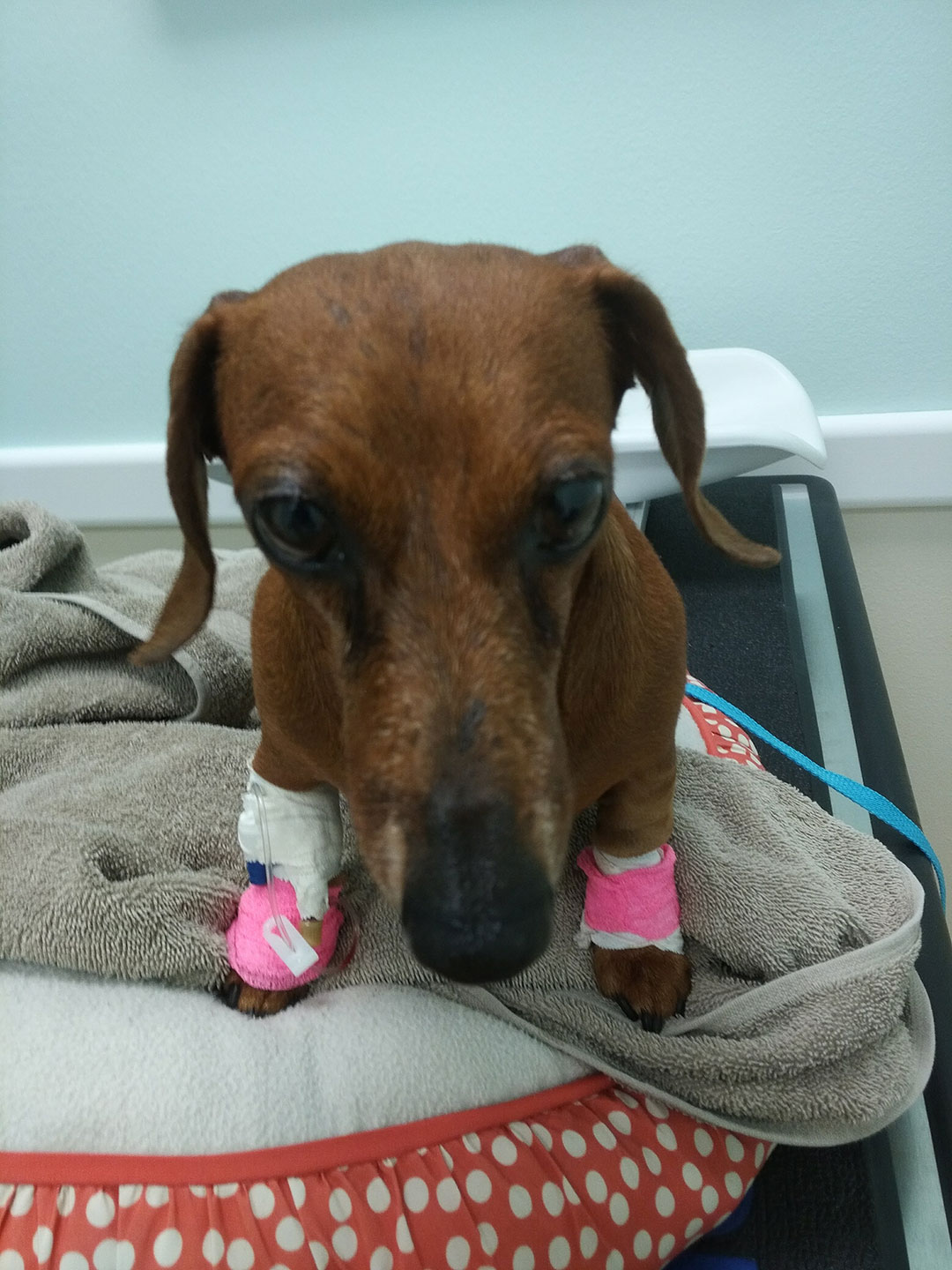A tale of two hearts: Mini Dachshund responds to novel treatment for dangerous arrhythmia

Ruby is a tiny dog with a big problem. In the span of nine months, the nine-year-old miniature Dachshund has been hospitalized 18 times. Now she’s on an operating table at the Cornell University Hospital for Animals, where owners Janet Nichol and Catherine Urbanski have brought her in a final attempt to mend her faulty heart.
Ruby suffers from ventricular tachycardia, a condition making her heart beat at a rapid and dangerous pace due to damage in the right ventricle. This condition is a type of arrhythmia usually controlled with medication, though for Ruby, the drugs proved more of a bandage than a permanent fix.
“When she was on medication she was perfect, but the longest period of time where the medication worked was five weeks,” says Urbanski.
Cornell is one of only two places in the United States and the only veterinary college that routinely offers the delicate and precise procedure Ruby needs: radiofrequency catheter ablation, where small areas of the heart muscle are heated through the tip of a catheter to destroy harmful tissue. Dr. Roberto Santilli, cardiologist and adjunct professor, and Dr. Romain Pariaut, section chief of cardiology and associate professor in the Department of Clinical Sciences, are the experts in the operating room. When they are ready to proceed, Santilli guides the catheters, assisted by Pariaut. They are supported by the other members of the cardiology team, including cardiology residents Shana Mintz ’11, D.V.M. ’15, and Dr. Christophe Bourguignon.
Over several hours, the team ablates a remarkable 42 spots in Ruby’s tiny heart.
The long road to Cornell
This time last year, Ruby was in dire straits. After playing in the yard one day, she emerged from the bushes moving slowly and without her usual pep. Nichol and Urbanski noticed that her heart was racing and took her to an emergency veterinary clinic.
“The very first time she went into tachycardia in Florida, they thought it was because she had eaten a frog, that it was an allergic reaction,” says Nichol. “Then a few weeks later when we were back home in Toronto, again the same thing happened.”

Ruby’s home veterinarian, Dr. Destiny Locking, kept a close watch on the dog’s condition. “I will never forget the day that Ruby’s owners came to me after several visits to the ICU in Toronto and multiple referrals to veterinary specialists both in Canada and the USA,” says Locking. “They had a look of desperation on their faces and said, ‘Destiny, you have to save her.’ I couldn’t sleep. I didn’t want to give up.”
One day she read how clinicians at Cornell saved the life of a dog with a similar condition — Rex, a German Shepherd puppy — and sent Ruby’s medical record to Santilli. During each occurrence of tachycardia, Ruby’s heart rate would reach a startling 350 beats-per-minute, and all the damage appeared to be in the same area of the heart. The veterinarians agreed that this made her a good candidate for the same radiofrequency catheter ablation procedure as Rex, despite their different diseases.
“It was a eureka moment!” says Locking. “Ruby was the most challenging case in my career thus far. She taught me never to give up.”
“Dr. Locking read the article about Rex, and we tried it because we were at our wit’s end,” says Urbanski. “There wasn’t anything further we could do until we heard about this. It was our last attempt to try to help her have a normal mini Dachshund life.”
From German Shepherd to mini Dachshund
While Rex’s story might have inspired Ruby’s visit to Cornell, the two cases have key differences, mainly in disease type and size of the patient. Rex suffered from a congenital disease; he was born with a bundle of abnormal muscle in a sensitive area in his heart that caused his arrhythmia. Ruby had developed a disease called arrhythmogenic right ventricular cardiomyopathy that affected a large section of her right ventricle, most commonly seen in this form in English Bulldogs.
“Over time, the connections between the cells of the heart weaken, so you have different areas where the muscle dies and is replaced with fibrosis and fatty tissue,” says Santilli.
And even as a puppy, Rex was nearly twice her size. Ruby weighs in at only 10 pounds, which proves to be the biggest challenge for the cardiology team in the operating room.
“It’s a very tiny heart,” says Pariaut. “The catheters we use are designed for humans, so we can flex and curve them, but the curve is designed to fit in an adult human’s heart.”
Despite these differences, Rex and Ruby both faced an arrhythmia that threatened their lives, and became alumni of the same novel procedure that saved it.
Preparations and procedure
To prepare Ruby for radiofrequency catheter ablation, Santilli and Pariaut stop all her medications. This is to make it more likely for tachycardia to occur, which they need to happen in order to map it. Mapping involves observing the electrical activity in the heart. “We can see differences in the characteristic of the electrical signal that travels through the heart muscle and determine if it is healthy or damaged,” says Pariaut. “You can see an abnormal electrical current.”
“We were looking for what we called ‘sick’ electrical potentials in the heart, places where the heart tissue was not normal,” says Santilli.
Once mapped, they will know what muscles need the most attention.
Ruby checks in to Cornell on Monday and by Thursday night she goes into tachycardia. They assemble the cardiology team and operate on Ruby the next day, a few days ahead of schedule.
With Santilli and Pariaut at the helm, the hours-long procedure goes smoothly.
“Dr. Santilli and his team were fabulous. They were fantastic, the whole operation,” says Nichol. “And she’s doing wonderfully! She has bounced right back.”
Pariaut says they will recheck Ruby every year to ensure she’s doing well. In order to monitor her, Cornell will send a Holter that collects ECG data to Locking at her practice in Port Colborne. Locking will put it on Ruby for 24 hours and then send it back. If there’s no indication of any abnormalities, they will only have to repeat the Holter once a year. Otherwise they will check every six months to see whether the arrhythmia returns. “So far it hasn’t,” says Pariaut.
Nichol and Urbanski are doing their part to monitor Ruby as well. The pair check her daily with a stethoscope, and say she is her typical miniature Dachshund self — guarding the house, chasing squirrels and terrorizing geckos. Says Urbanski, “She’s a very playful, one-of-a-kind little dog.”
Taking an initiative

Although many types of arrhythmia can be treated with ablation, most are managed by medication with varying degrees of success. Santilli and Pariaut are working to raise awareness that the ablations performed on Rex and Ruby could extend and increase the quality of life for many dogs.
“It’s important to know what type of arrhythmia it is, where it comes from, what’s the mechanism,” says Pariaut, “because that can help us decide if there’s another way to manage it — not always just giving the same drugs.”
Rex’s owners agree with this vision, and created the Henry and Karen Silverman Initiative to Advance Treatment of Canine Arrhythmias to make it more well-known.
“All of this was because of Rex and his story,” says Nichol. “He’s the only reason we knew about this, and we’re grateful that Dr. Locking is a veterinarian who keeps up on articles and is always researching. She found it for us and it worked. What Dr. Santilli and the team did is just unbelievable, and we are so grateful that this happened.”
By Melanie Greaver Cordova




